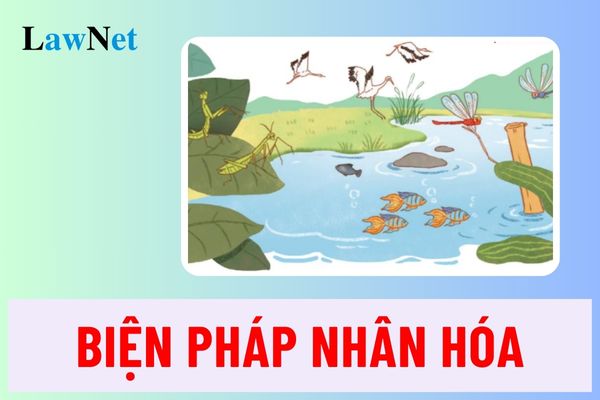What is personification according to the Literature in Vietnam? What are effects and some examples of personification?
What is personification according to the Literature in Vietnam? What are effects and some examples of personification?
Personification is a very common rhetorical device in literature, making sentences more lively and engaging.
When using personification, we attribute characteristics, actions, and personalities specific to humans to inanimate objects, phenomena, and animals. Thanks to this, those lifeless objects become closer and more spirited.
(1) Characteristics of the Personification:
- Assign human characteristics to objects and phenomena such as thoughts, feelings, actions...
- Create liveliness and closeness to help readers easily visualize and perceive the object or phenomenon.
- Enhance the image and emotion of the sentence to make the sentence more attractive and impressive.
(2) Examples of Personification:
Example of personification for objects:
The old banyan tree stood pensively looking at the flowing river. (Personification of the banyan tree with the action "pensively looking")
The houses sleep quietly in the late night. (Personification of the houses with the action "sleep quietly")
The lazy sun hides behind the clouds. (Personification of the sun with the characteristic "lazy")
The country road stretches to greet the dawn. (Personification of the road with the action "stretches")
Example of personification for natural phenomena:
The wind sings a melodious love song. (Personification of the wind with the action "sings")
The rain falls softly as if someone is crying. (Personification of the rain with the action "crying")
The sea waves lap against the shore. (Personification of the sea waves with the action "lap")
The moon floats in the sky like a giant lantern. (Personification of the moon with the image of "lantern")
Example of personification for animals:
The cat meows demandingly for food. (Personification of the cat with the characteristic "demandingly")
The songbird chirps merrily on the branch. (Personification of the bird by assigning it human action)
Example of personification for utensils:
The book is like a close companion. (Personification of the book with the role "companion")
The pen lies quietly in the pencil case. (Personification of the pen with the state "quietly")
(3) Effects of the Personification:
- Make the text lively and attractive to help the reader easily visualize and appreciate the beauty of the object or phenomenon.
- Enhance the image and emotion to make the sentence full of images, sounds, colors.
- Stimulate the reader’s imagination to help readers associate, imagine beautiful, lively images.
- Create sentences rich in artistic value to make the text more beautiful, impressive.
Note: The above content is for reference only.

What is personification according to the Literature in Vietnam? What are effects and some examples of personification? (Image from the Internet)
Who are subjects of the 2018 General Education Program for Literature in Vietnam?
Based on Section 1 of the General Education Program for Literature issued in conjunction with Circular 32/2018/TT-BGDDT:
I. CHARACTERISTICS OF THE SUBJECT
Literature is a subject in the field of Language and Literature Education, taught from grade 1 to grade 12. At the primary level, this subject is called Vietnamese; at the lower and upper secondary levels, it is called Literature.
Literature is a subject of both instrumental and aesthetic - humane nature; helping students have a means of communication, forming a basis to learn all other subjects and educational activities in schools; it is also an important tool to educate students on the noble values of culture, literature, and national language; developing in students healthy emotions, humane sentiments, benevolent and altruistic lifestyle, etc.
...
The target of the 2018 General Education Program for Literature is students from grade 1 to grade 12.
What are the requirements for students when learning about rhetorical devices in the 2018 General Education Program for Literature in Vietnam?
Based on Clause 2, Section 4 of the General Education Program for Literature issued in conjunction with Circular 32/2018/TT-BGDDT
2. Specific Competencies Required
2.1. Competencies required at the primary level
a) Language competence
...
b) Literary competence
Distinguish between narrative texts and poetry (passages, prose and verses); recognize the content of the text and the attitude, feelings of the writer; initially understand the effects of some formal elements of literary texts (words, characters, plot, rhythm, metaphors, personification). Know how to associate, imagine, and express literary qualities in writing and speaking.
For students in grade 1 and grade 2: recognize who or what the text is about; recognize the characters in stories, rhythms in poems; distinguish between stories and poems.
For students in grades 3, 4, and 5: know how to read literary texts expressively; retell and summarize the main content of stories and poems; comment on characters, events, and the writer's attitude and feelings in the text; recognize time and place, some types of poetry rhythms, beautiful, unique words, and images and the effects of personification and simile rhetorical devices. Understand the meaning or lesson derived from the text. Write narrative and descriptive passages or texts that show emotions and imaginative abilities.
According to above regulations:
- For students in grade 3, grade 4, and grade 5, they must know the effects of personification and simile rhetorical devices.
- For students in grades 6 and 7, they must know rhetorical devices such as metaphor, metonymy, hyperbole, litotes.
- For students in grades 8 and 9, they must understand rhetorical devices such as repetition, wordplay, sarcasm, paradox.

